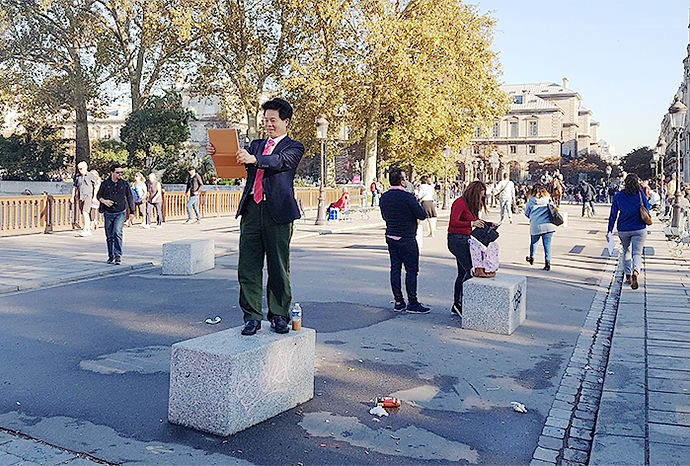
In front of the Notre Dame cathedral, solid granite blocks are placed in various spots around the square and on the adjacent pedestrian roads. Their surfaces are smooth, edges rounded. Almost elegantly, their material texture and colour match the typical Parisian curb sides. Tourists sit on these objects when the classic wood-and-iron ‘Davioud’ benches on the bridge are occupied. Others use them as a step to take pictures, or a plinth to pose on. Despite their appropriation as urban furniture, the positioning of the blocks also suggests another function though. During the day, a police car blocks the only opening in the line-up of blocks on one side of the square, while during special events a bright yellow so-called ‘mobile anti-terrorism barrier’ is installed across a gap in the arrangement on the opposite side. It is hard to overlook these obstacles’ function as a security measure to prevent trucks and cars from driving into the crowds of tourists lingering in front of the cathedral.
In this respect, their purpose is similar to many of the rough concrete barriers with lifting holes and metal hooks that can be found around buildings and squares elsewhere in the city, and they fit into a broader set of government-led ‘Vigipirate’ security measures including metal detector gates at public buildings and the frequent presence of armed military personnel on the streets. However, most of these measures are likely to constitute a clear rupture in the everyday experience of the urban landscape, evoking an immediate sense of threat and emergency, or even a state of warfare. Instead, the granite blocks around the Notre Dame are more ambiguous. They afford being simultaneously perceived as public furniture and anti-terrorism measure. As such, they seem characteristic of changes in the organization of public space that have persisted beyond the end of the state of emergency, which lasted from 2015 until 2017. This deluxe successor of the concrete, temporary anti-truck roadblock blends into its urban environment and is widely embraced by users of public space as an object of convenience. However, its conspicuously strategic positioning, as well as its shape that is reminiscent of its concrete predecessors, make that it never becomes entirely dissociated from its place in the paradigm of security and threat. These objects act as half-conscious reminders of a condition of fear and threat that is lurking just below the surface of the cheerful hustling and bustling of the touristy everyday of this site.
As such, they fit in with a broader cultural development in the engagement with security and threat. In The Administration of Fear (2012), Paul Virilio discusses how the proliferation of digital news media over the past two decades has led to the distribution of more news events at ever increasing speeds. Through 24/7 news feeds, updates on the latest incidents all over the world are disseminated almost instantly and continuously. Instead of facilitating a more detailed assessment of events and thus trigger empathetic action on the side of the recipient, the fast sequence of detailed mediatizations of catastrophes and threats paradoxically promotes a permanent state of fear. Whereas, in previous media eras, fear used to be ‘related to localized, identifiable events that were limited to a certain timeframe’, it has now increasingly become an ‘environment, an everyday landscape’. In this context, the ambiguity of the granite block, its affordance as quasi-ordinary urban furniture, and its appearance as a permanent structure are significant: once fully integrated in the grid of the urban everyday, the deluxe anti-terrorism barrier becomes a literal, material manifestation of the ‘everyday landscape’ of the administration of fear.
Paris, November 2018
Paul Virilio, 2012. The Adminstration of Fear. London / New York: Semiotext(e)